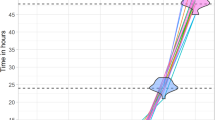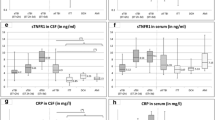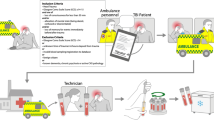Abstract
The aim of the given study was to test the in situ stability of biochemical markers of cerebral damage and acute phase response in the early post-mortem interval to assess their usability for forensic pathology. A monocentric, prospective study investigated post-mortem femoral venous blood samples at four time points obtained within 48 h post-mortem starting at the death of 20 deceased, using commercial immunoassays for the ten parameters: S100 calcium-binding protein B (S100B), glial fibrillary acidic protein (GFAP), neuron-specific enolase (NSE), brain-derived neurotrophic factor (BDNF), interleukin-6 (IL-6), C-reactive protein (CRP), procalcitonin (PCT), ferritin, soluble tumor necrosis factor receptor type 1 (sTNFR1), and lactate dehydrogenase (LDH). Significant changes in serum levels were observed only later than 2 h after death for all markers. Inter-laboratory comparability was high, and intra-assay precision was sufficient for most markers. Most of the biomarker levels depended on the severity of hemolysis and lipemia but were robust against freeze-thaw cycles. Serum levels increased with longer post-mortem intervals for S100B, NSE, ferritin, sTNFR1, and LDH (for all p < 0.001) but decreased over this period for CRP (p = 0.089) and PCT (p < 0.001). Largely unchanged median values were found for GFAP (p = 0.139), BDNF (p = 0.106), and IL-6 (p = 0.094). Serum levels of CRP (p = 0.059) and LDH (p = 0.109) did not differ significantly between the final ante-mortem (resuscitation) and the first post-mortem sample (moment of death). Collecting the post-mortem blood sample as soon as possible will reduce the influence of post-mortem blood changes. Serum GFAP for detection of cerebral damage as well as serum IL-6 and CRP as proof of acute phase response seemed to be preferable due to their in situ stability in the first 2 days after death.




Similar content being viewed by others
References
Coe J (1993) Post-mortem chemistry update. Emphasis on forensic application. Am J Forensic Med Pathol 14:91–111
Palmiere C, Mangin P (2012a) Post-mortem chemistry update part I. Int J Legal Med 126:187–198
Palmiere C, Mangin P (2012b) Post-mortem chemistry update part II. Int J Legal Med 126:199–215
Maeda H, Zhu BL, Ishikawa T, Quan L, Michiue T (2009) Significance of post-mortem biochemistry in determining the cause of death. Legal Med 11:46–49
Luna A (2009) Is post-mortem biochemistry really useful? Why is it not widely used in forensic pathology? Legal Med 11:27–30
Ondruschka B, Schuch S, Pohlers D, Franke H, Dreßler J (2018) Acute phase response after fatal traumatic brain injury. Int J Legal Med 132:531–539.
Ondruschka B, Sieber M, Kirsten H; Franke H, Dreßler J (2018) Measurement of cerebral biomarkers proving traumatic brain injuries in post-mortem body fluids. J Neurotrauma 35:2044–2055.
Sieber M, Dreßler J, Franke, Pohlers D, Ondruschka B (2018) Post-mortem biochemistry of NSE and S100B. A supplemental tool for detecting a lethal traumatic brain injury? J Forensic Legal Med 55:65–73.
Woodcock T, Morganti-Kossmann MC (2013) The role of markers of inflammation in traumatic brain injury. Front Neurol 4:18
Tsokos M, Reichelt U, Jung R, Nierhaus A, Püschel K (2001) Interleukin-6 and C-reactive protein serum levels in sepsis-related fatalities during the early postmortem period. Forensic Sci Int 119:47–56.
Tsokos M, Reichelt U, Nierhaus A, Püschel K (2001) Serum procalcitonin (PCT): a valuable biochemical parameter for the post-mortem diagnosis of sepsis. Int J Legal Med 114:237–243.
Soar J, Nolan JP, Böttiger BW, Perkins GD, Loot C, Carli P, Pellis T, Sandroni C, Skrifvars MB, Smith GB, Sunde K, Deakin CD et al (2015) European resuscitation council guidelines for resuscitation 2015. Section 3. Adult advanced life support. Resuscitation 95:100–147
Hess C, Krueger L, Unger M, Madea B (2017) Freeze- and -thaw stability and long-term-stability of 84 synthetic cannabinoids in serum. Drug Test Anal 9:1506–1511
German Medical Assocation (2015) Revision of the “Guideline of the German Medical Association on quality assurance in medical laboratory examinations - Rili-BAEK”. J Lab Med 39:26–69
Ishikawa T, Hamel M, Zhu B-L, Li D-R, Zhao D, Michiue T, Maeda H (2008) Comparative evaluation of postmortem serum concentrations of neopterin and C-reactive protein. Forensic Sci Int 179:135–143
Palmiere C, Bardy D, Mangin P, Augsburger M (2013) Value of sTREM-1, procalcitonin and CRP as laboratory parameters for postmortem diagnosis of sepsis. J Inf Secur 67:545–555
Bode-Jänisch S, Schütz S, Schmidt A, Tschernig T, Debertin AS, Fieguth A, Hagemeier L, Teske J, Suerbaum S, Klintschar M, Bange FC (2013) Serum procalcitonin levels in the postmortem diagnosis of sepsis. Forensic Sci Int 226:266–272
Majdan M, Plancikova D, Brazinova A, Rusnak M, Nieboer D, Feigin V, Maas A (2016) Epidemiology of traumatic brain injuries in Europe: a cross-sectional analysis. Lancet Public Health 1:e76–e83
Blennow K, Brody DL, Kochanek PM, Levin H, McKee A, Ribbers GM, Yaffe K, Zetterberg H (2016) Traumatic brain injuries. Nat Rev Dis Primers 2:16084
Chirica VI (2017) Useful markers to assess traumatic and hypoxic brain injury. Rom J Legal Med 25:146–151
Wang KK, Yang Z, Zhu T, Shi Y, Rubenstein R, Tyndall JA, Manley GT (2018) An update on diagnostic and prognostic biomarkers for traumatic brain injury. Expert Rev Mol Diagn 18:165–180
Li DR, Zhu BL, Ishikawa T, Zhao D, Michiue T, Maeda H (2006a) Postmortem serum protein S100B levels with regard to the cause of death involving brain damage in medicolegal autopsy cases. Legal Med 8:71–77
Li DR, Zhu BL, Ishikawa T, Zhao D, Michiue T, Maeda H (2006b) Immunohistochemical distribution of S-100 protein in the cerebral cortex with regard to the cause of death in forensic autopsy. Legal Med 8:78–85
Goede A, Dreßler J, Sommer G, Schober K, Franke H, Ondruschka B (2015) Wundalterdiagnostik nach letalem Schädel-Hirn-Trauma. Rechtsmedizin 25:261–267
Ondruschka B, Pohlers D, Sommer G, Schober K, Teupser D, Franke H, Dreßler J (2013) S100B and NSE as useful postmortem biochemical markers of traumatic brain injury in autopsy cases. J Neurotrauma 30:1862–1871
Osuna E, Perez-Carceles MD, Luna A, Pounder DJ (1992) Efficacy of cerebro-spinal fluid biochemistry in the diagnosis of brain insult. Forensic Sci Int 52:193–198
Raabe A, Kopetsch O, Groß U, Zimmermann M, Gebhart P (2003) Measurements of serum S-100B protein: effects of storage time and temperature on pre-analytical stability. Clin Chem Lab Med 41:700–703
Beaudeux JL, Léger P, Dequen L, Gandjbakhch I, Coriat P, Foglietti MJ (2000) Influence of hemolysis on the measurement of S-100 protein and neuron-specific enolase plasma concentrations during coronary artery bypass grafting. Clin Chem 46:989–990
Missler U, Wiesmann M, Wittmann G (1999) Measurement of glial fibrillary acidic protein in human blood: analytical method and preliminary clinical results. Clin Chem 45:138–141
Ramont L, Thoannes H, Volondat, Chastang F, Millet MC, Maquart FX (2005) Effects of hemolysis and storage condition on neuron-specific enolase (NSE) in cerebrospinal fluid and serum: implications in clinical practice. Clin Chem Lab Med 43:1215–1217
Verfaillie CJ, Delanghe JR (2010) Hemolysis correction factor in the measurement of serum neuron-specific enolase. Clin Chem Lab Med 48:891–892
Korley FK, Diaz-Arrastia R, Wu AH, Yue JK, Manley GT, Sair HI, Van Eyk J, Everett AD et al (2016) Circulating brain-derived neurotrophic factor has diagnostic and prognostic value in traumatic brain injury. J Neurotrauma 33:215–225
Failla MD, Conley YP, Wagner AK (2016) Brain-derived neurotrophic factor (BDNF) in traumatic brain injury-related mortality: interrelationships between genetics and acute systemic and central nervous system BDNF profiles. Neurorehabil Neural Repair 30:83–93
Tsokos M (2007) Postmortem diagnosis of sepsis. Forensic Sci Int 165:155–164
Mimasaka S, Funayama M, Hashiyada M, Nata M, Tsunenari S (2007) Significance of levels of IL-6 and IL-8 after trauma. A study of 11 cytokines post-mortem using multiplex immunoassay. Injury 38:1047–1051
Schrag B, Roux-Lombard P, Schneiter D, Vaucher P, Mangin P, Palmiere C (2012) Evaluation of C-reactive protein, procalcitonin, tumor necrosis factor alpha, interleukin-6, and interleukin-8 as diagnostic parameters in sepsis-related fatalities. Int J Legal Med 126:505–512
Fujita MQ, Zhu B-L, Ishida K, Quan L, Oritani S, Maeda H (2002) Serum C-reactive protein levels in postmortem blood—an analysis with special reference to the cause of death and survival time. Forensic Sci Int 130:160–166
Astrup BS, Thomsen JL (2007) The routine use of C-reactive protein in forensic investigations. Forensic Sci Int 172:49–55
Maeda H, Zhu B-L, Bessho Y, Ishikawa T, Quan L, Michiue T, Zhao D, Li D-R, Komatsu A (2008) Postmortem serum nitrogen compounds and C-reactive protein levels with special regard to investigation of fatal hyperthermia. Forensic Sci Med Pathol 4:175–180
Uhlin-Hansen L (2001) C-reactive protein (CRP), a comparison of pre- and post-mortem blood levels. Forensic Sci Int 124:32–35
Palmiere C, Augsburger M (2014) Markers for sepsis diagnosis in the forensic setting. State of the art. Croat Med J 55:103–114
Schmidt S, Windgassen M, Nofer J-R, Pfeiffer H, Ribbecke S, Schmeling A (2015) Procalcitonin as a postmortem sepsis marker. A comparison of the validity of results obtained from blood serum, aqueous humour and cerebrospinal fluid. Int J Legal Med 129:117–123
Ramsthaler F, Kettner M, Mall G, Bratzke H (2008) The use of rapid diagnostic test of procalcitonin serum levels for the postmortem diagnosis of sepsis. Forensic Sci Int 178:139–145
Meisner M, Tschaikowsky K, Schnabel S, Schmidt J, Katalinic A, Schüttler J (1997) Procalcitonin - influence of temperature, storage, anticoagulation and arterial or venous asservation of blood samples on procalcitonin concentrations. Clin Chem Lab Med 35:597–602.
Madea B, Musshoff F (2007) Post-mortem biochemistry. Forensic Sci Int 165:165–171
Flanagan RJ (2017) Post-mortem biochemistry and toxicology. Arab J For Sci For Med 1:540–552
Hanrieder J, Wetterhall M, Enblad P, Hillered L, Bergquist J (2009) Temporally resolved differential proteomic analysis of human ventricular CSF for monitoring traumatic brain injury biomarker candidates. J Neurosci Methods 177:469–478
Acknowledgments
The authors would like to thank Ms. Aqeeda Singh (Department of Anatomy, University of Otago, New Zealand) for proofreading the paper as a native speaker and Prof. Ralph Burkhardt (Institute of Laboratory Medicine, Clinical Chemistry and Molecular Diagnostics, University of Leipzig, Germany) for his kind support in aliquot checking of serum interference indices.
Author information
Authors and Affiliations
Corresponding author
Ethics declarations
All experiments were conducted in accordance with the human and ethical principles of the University of Leipzig (no. 388/15-ek).
Conflict of interest
BO has received reimbursement of travel costs from Randox Laboratories. The authors declare no competing interests.
Rights and permissions
About this article
Cite this article
Ondruschka, B., Woydt, L., Bernhard, M. et al. Post-mortem in situ stability of serum markers of cerebral damage and acute phase response. Int J Legal Med 133, 871–881 (2019). https://doi.org/10.1007/s00414-018-1925-2
Received:
Accepted:
Published:
Issue Date:
DOI: https://doi.org/10.1007/s00414-018-1925-2




